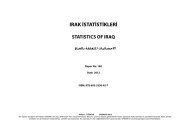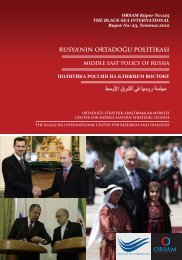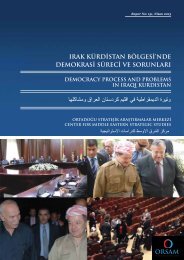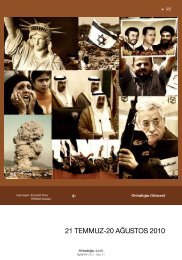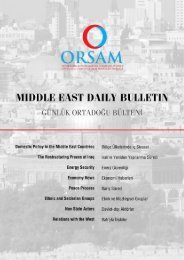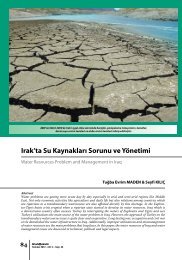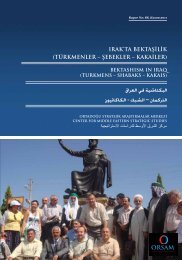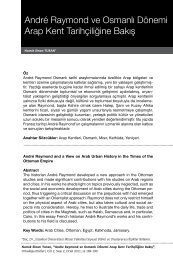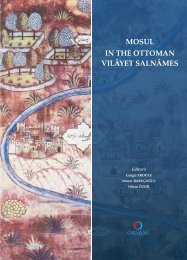IRAK ÇERKESLERİ - orsam
IRAK ÇERKESLERİ - orsam
IRAK ÇERKESLERİ - orsam
Create successful ePaper yourself
Turn your PDF publications into a flip-book with our unique Google optimized e-Paper software.
Presentation<br />
North Caucasians or commonly known as Circassians were exiled from their hometown North Caucasus<br />
by the Tsardom of Russia as of 21 May 1864, in the aftermath of the Russian-Caucasus War.<br />
As a part of the settlement process in the Ottoman Empire, they were settled in current Iraq as of<br />
1864. The Circassian migration into current Iraqi territories continued until the early 1920. In the<br />
last period of the Ottoman Empire and during the first years of Iraq’s independence, Circassians<br />
who were influential in social, cultural and political life of Iraq is currently an overshadowed part<br />
of the Iraqi society. The Ottoman Empire made use of the uncultivated lands thanks to Circassians,<br />
who had higher agricultural techniques compared to the local people. The Empire also benefited<br />
from Circassians, who had strong military tradition, against the rising independence movements.<br />
In addition, Circassians increased the Muslim population within the Ottoman Empire. The settlement<br />
of Circassians in Iraq took place in two stages: Directly from Northwestern Caucasus, and<br />
from Balkans. Circassian migrants contributed to the economic development of the regions they<br />
were settled in Iraq. They started to produce more developed agricultural implements and double<br />
massive wooden wheeled and iron hooped wagons, and build stone houses and mills. They implemented<br />
developed traditional agricultural techniques to a large extent, and they grew new plants<br />
such as millet and oat. They also brought along a great order in household appliances (use of iron,<br />
sewing machine, and eating at the table) from North Caucasus. Besides they were hardworking.<br />
They cleaned their fields from stones. So that almost all of them reached a standard of living that<br />
might be considered as wealthy.<br />
The North Caucasians settled in current Iraq were Chechens, Dagestanis, and Adyghes. The aforesaid<br />
families were settled in Kirkuk, Diyala, Baghdad, Mosul and Fallujah. Besides, families coming<br />
from North and South Dagestan were settled in Duhok, Erbil and Sulaymaniyah. In addition, there<br />
were bureaucrats, commanders and military families who joined the Ottoman army and did not<br />
leave Iraq even after the collapse of the Ottoman Empire. The Chechen people in Fishabur firstly<br />
settled on the left side of the Tigris River right across Tikrit, after passing through Mosul. Afterwards,<br />
they passed to other areas. Therefore, the area where Chechens lived together in Baghdad<br />
was called “Chechen Neighborhood”. The predictions on those who came from North Caucasus<br />
to Iraq show difference to a considerable extent. There is no accurate census results. In the light<br />
of this information, it might be suggested that 10 thousand people were settled in the area. Today,<br />
on the other hand, this population is claimed to be composed of 2 thousand, 15 thousand and 30<br />
thousand people. We should also take into consideration that a substantial amount of this population<br />
were Arabized, Kurdified and Turkmenized. Currently, the aforementioned population lives in<br />
Duhok, eastern Zaho, southern Erbil, Kirkuk, Tuz Khourmatu, Diyala, Fallujah and Sulaymaniyah.<br />
In addition, there are hundreds of families dispersed across various cities of Iraq. Approximately<br />
500 Chechen, Dagestani and Adyghe families live in Baghdad. In Iraq, North Caucasians continue<br />
to preserve certain North Caucasian traditions in their wedding ceremonies, birth and some other<br />
special days; and to cook their traditional food. Circassians, who were exposed to great pressure<br />
by the Baghdad administration during Saddam period as an extension of the Ottoman Empire and<br />
Turkey, started to create democratic organizations without any support from the government following<br />
the 2003 Iraqi invasion of the U.S. Within this scope, Al-Tadamun Society of Iraqi, Chechen,<br />
Dagestani and Circassian Tribes was established in 2004, and they started to publish the magazine<br />
called Al-Tadamun. The headquarter of the aforesaid society is located in Kirkuk.<br />
ORSAM has come to the fore in the public opinion in a short period of time through the field<br />
studies especially carried out on Iraq, as well as the reports, magazines and articles it published.<br />
ORSAM has been trying to facilitate establishing dialogues between the parties and to contribute<br />
developing the concepts of reconciliation and cooperation without getting involved in polarized<br />
axes among the local communities, especially during the studies carried out. While the process Iraq<br />
went through after 2003 was defined as a democracy process for some, and as disintegration process<br />
for others; we avoid such definitions in studies we carry out as ORSAM. While ORSAM reports<br />
aim at Iraq’s being understood better, those reports also aim at being the voice to groups forgotten<br />
and unheard within the natural structure of Iraq. This study is also one of ORSAM’s studies on Iraq.<br />
Having a deep-rooted history in Iraq, Iraqi Circassians are currently seeking their identity again<br />
and they strive to preserve their existence. I hope this report would be useful for those who are<br />
interested in the subject. Sincerely.<br />
Hasan KANBOLAT<br />
ORSAM Director<br />
4<br />
ORSAM<br />
Report No: 134, November 2012




